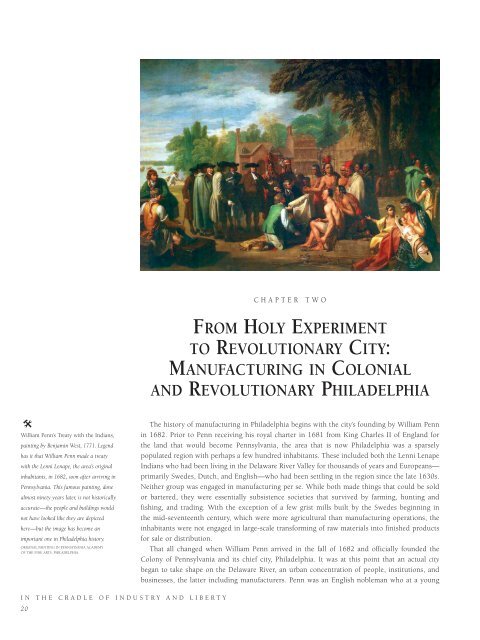In The Cradle of Industry and Liberty
An illustrated history of Philadelphia's manufacturing sector paired with the histories of local companies that make the city great.
An illustrated history of Philadelphia's manufacturing sector paired with the histories of local companies that make the city great.
Create successful ePaper yourself
Turn your PDF publications into a flip-book with our unique Google optimized e-Paper software.
CHAPTER<br />
TWO<br />
FROM HOLY EXPERIMENT<br />
TO REVOLUTIONARY CITY:<br />
MANUFACTURING IN COLONIAL<br />
AND REVOLUTIONARY PHILADELPHIA<br />
@<br />
William Penn’s Treaty with the <strong>In</strong>dians,<br />
painting by Benjamin West, 1771. Legend<br />
has it that William Penn made a treaty<br />
with the Lenni Lenape, the area’s original<br />
inhabitants, in 1682, soon after arriving in<br />
Pennsylvania. This famous painting, done<br />
almost ninety years later, is not historically<br />
accurate—the people <strong>and</strong> buildings would<br />
not have looked like they are depicted<br />
here—but the image has become an<br />
important one in Philadelphia history.<br />
ORIGINAL PAINTING IN PENNSYLVANIA ACADEMY<br />
OF THE FINE ARTS, PHILADELPHIA.<br />
<strong>The</strong> history <strong>of</strong> manufacturing in Philadelphia begins with the city’s founding by William Penn<br />
in 1682. Prior to Penn receiving his royal charter in 1681 from King Charles II <strong>of</strong> Engl<strong>and</strong> for<br />
the l<strong>and</strong> that would become Pennsylvania, the area that is now Philadelphia was a sparsely<br />
populated region with perhaps a few hundred inhabitants. <strong>The</strong>se included both the Lenni Lenape<br />
<strong>In</strong>dians who had been living in the Delaware River Valley for thous<strong>and</strong>s <strong>of</strong> years <strong>and</strong> Europeans—<br />
primarily Swedes, Dutch, <strong>and</strong> English—who had been settling in the region since the late 1630s.<br />
Neither group was engaged in manufacturing per se. While both made things that could be sold<br />
or bartered, they were essentially subsistence societies that survived by farming, hunting <strong>and</strong><br />
fishing, <strong>and</strong> trading. With the exception <strong>of</strong> a few grist mills built by the Swedes beginning in<br />
the mid-seventeenth century, which were more agricultural than manufacturing operations, the<br />
inhabitants were not engaged in large-scale transforming <strong>of</strong> raw materials into finished products<br />
for sale or distribution.<br />
That all changed when William Penn arrived in the fall <strong>of</strong> 1682 <strong>and</strong> <strong>of</strong>ficially founded the<br />
Colony <strong>of</strong> Pennsylvania <strong>and</strong> its chief city, Philadelphia. It was at this point that an actual city<br />
began to take shape on the Delaware River, an urban concentration <strong>of</strong> people, institutions, <strong>and</strong><br />
businesses, the latter including manufacturers. Penn was an English nobleman who at a young<br />
IN THE CRADLE OF INDUSTRY AND LIBERTY<br />
20
















